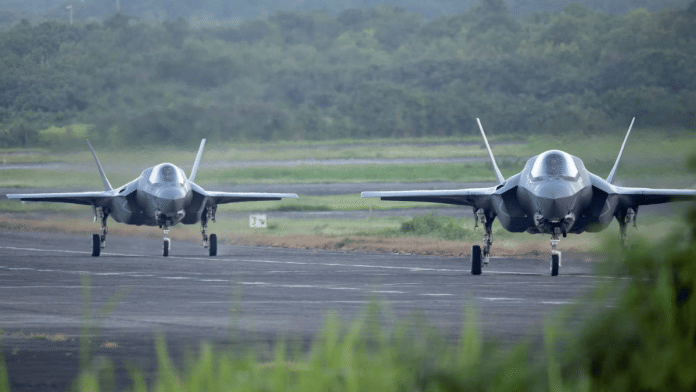China has unveiled the hangars of its most advanced J-35 and J-35A stealth fighters, sea and air twins, at the Shenyang Aircraft Corporation in Shenyang, Liaoning, in a calculated display of strength. The timing and spectacle suggest more than a technical milestone. Slated for service in 2025, the J-35s have been portrayed in domestic discourse as a game-changer for carrier and coastal air power.
Military unveilings in China have long been instruments of narrative projection, and the J-35 and J-35A are no exception. The display was designed to command attention, stir national pride, and underscore the message that China’s defence industry is closing the technological gap with the United States.
Social media erupted almost immediately. Platforms across China buzzed with comparisons to the US F-35, with commentators claiming the J-35s outperform its American rival and usher in a new era of carrier-based aviation. Headlines such as “catapult factory goes bankrupt” and “The J-35 stealth carrier-based fighter enters the countdown to service” radiate triumphalist confidence, echoing narratives of technological ascendancy.
New stealth fighters rewrite China’s air power playbook
In Chinese military discourse, the J-35 and J-35A are portrayed as a turning point in the country’s pursuit of air dominance. Far beyond new-generation aircraft, they serve as symbols of national confidence and mastery over technologies once monopolised by the West.
Commentators have presented the J-35 series as the backbone of a modern stealth and counter-stealth system, combining air-superiority and precision-strike capabilities across all domains. Sun Cong, chief designer at the Chinese Academy of Engineering, highlighted its defining features: advanced stealth shaping, integrated information systems, and a compact, unified design. Electromagnetic catapult launches from the carrier Fujian have been widely circulated as proof of China’s self-reliant leap in naval aviation.
He further highlighted that China’s system-centric approach allows Chengfei and Shenfei airframes to share modules and standards, enabling a single design to perform multiple roles. By contrast, US programmes such as the F-35 and NGAD remain constrained by fixed architectures and budget limits. The J-35 test flights signalled a paradigm shift: modular, AI-integrated fighters capable of rapid upgrades, unlike the static F-22 or the still-maturing Indian Tejas. Continuous evolution compresses development cycles and ensures China’s jets adapt swiftly to emerging threats, asserting clear regional superiority.
On platforms like Zhihu, the Chinese version of Quora, users framed the J-35 as part of a “three-domain” strike system spanning land, sea, and air, and noted that without the F-35, US strike options are slower and more constrained, underscoring China’s operational advantage.
Social media also highlighted the J-35’s agility. Armed with Eagle Strike-91 and AKF-98 missiles, it exploits radar gaps, targets high-value assets, and disrupts enemy formations. Rather than competing head-to-head with the F-35, it functions as a low-cost, nimble disruptor.
Reports suggest that with the WS-21 engine, the J-35 could become the world’s most powerful carrier-based fighter, capable of neutralising enemy aircraft in seconds.
Weibo discussions emphasised on design superiority: unlike the J-20, the J-35A omits pelvic fins; its flatter fuselage surpasses the F-35 in stealth optimisation. Wang Yongqing, chief engineer at Shenfei, described it as offering “the best stealth performance among fifth-generation fighters.”
China’s heavy-fighter development, from the Su-27 era to today’s fleet of over 1,300 aircraft, has created both numerical and technological superiority over the US. Modern jets such as the J-16, J-20, J35s, and emerging sixth-generation J-50 and J-36 models reinforce this lead.
Chinese analysts and media frame the China–US air power rivalry as a global focal point in 2025 and beyond. While the US Air Force remains larger overall, Chinese discourse emphasised that China now fields newer, more capable heavy aircraft, including carrier-capable J-35. In contrast, US fleets are depicted as ageing, undermaintained, and constrained by pilot shortages. Supported by advanced missiles, robust industry, and favourable geography, Chinese sources assert a clear edge in regional air power.
Chinese commentary further noted that by late 2025, at least 40 J-35s will enter Navy service, strengthening carrier operations and reinforcing the narrative of a shifting balance of air power in the Western Pacific.
Also read: China is run by engineers. India lacks such first-generation technocrats
Technology meets ambition
Chinese discourse has framed the J-35 as a symbol of the Air Force’s narrowing gap with the US, challenging perceptions that China lags behind. Commentary highlighted the fighter’s export appeal, portraying Chinese aircraft, including the J-35. as reliable alternatives to US systems in regions such as the Middle East. Reports of Pakistan receiving J-35s reinforce China’s growing regional influence.
Within China, the deployment of J-35s and the development of sixth-generation fighters are seen as accelerating the closing of gaps in scale, equipment, system integration, and technological capability relative to the US. Across Chinese narratives, the J-35 embodies both technological confidence and strategic maturity. It marks a new phase of military modernisation, showcasing advances in aviation, indigenous capabilities, and self-reliance, where visibility—through demonstrations, social media, and curated narratives—serves as a powerful instrument of influence.
The unveiling carries strategic weight. By putting the J-35s on public display, Beijing broadcasts capability and intent alike. It fuels nationalist pride at home while projecting power abroad. In Chinese discourse, the fighter is more than a weapon; it is a statement; an unmistakable signal that China is ready to challenge American air power on equal terms.
Sana Hashmi is a fellow at the Taiwan-Asia Exchange Foundation. She tweets @sanahashmi1. Views are personal.
(Edited by Saptak Datta)







Lmao, not battle tested like F-35 or F-15 or Rafale.